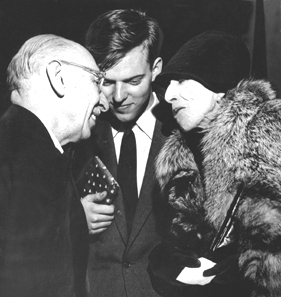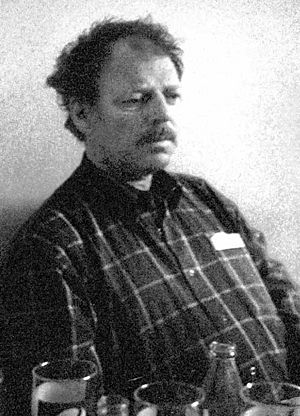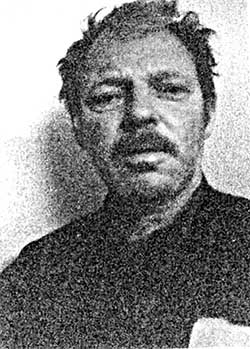Jurij Moskvitin facts for kids
Jurij Moskvitin (born Robert Jurij Moskvitin Hansen, 6 January 1938 – 25 May 2005) was a classical pianist, composer, philosopher, and mathematician. He was also known for his bohemian lifestyle.
Jurij Moskvitin grew up in Denmark. His mother was from a Russian noble family, and his father was a Danish engineer. After World War II, he studied music at The Royal Danish Academy of Music in Copenhagen. Later, he earned a master's degree in Philosophy from the University of Copenhagen.
He was friends with famous people like Isak Dinesen (Karen Blixen), Simon Spies, Tao Nørager, and Henrik Stangerup.
His works include:
- Essay on The Origin of Thought (1974) – a philosophy book.
- Det er spændende at tænke (It's Exciting to Think) (1976) – another philosophy book.
- Music for the movie "Jorden Er Flad" (The Earth is Flat) (1977) by Henrik Stangerup.
- Den store undren (The Great Wonder) (1992) – a philosophy book.
- Simon Spies. Historien om et venskab (Simon Spies. The Story of a Friendship) (1984–1999) – a biography.
- Den døve øgle (The Deaf Lizard) (2001) – his self-portrait.
- Du må ikke sjuske med dit liv (Thou Shalt Not Waste Thy Life) (2008) – a biography about Henrik Stangerup.
Jurij Moskvitin was a main character in the documentary "En aften i november" (An Evening in November). He was also interviewed in "At skrive eller dø & At forråde virkeligheden" (To Write or Die & To Betray Reality). This documentary was about his friendship with Henrik Stangerup. He often appeared on the Danish TV show "Smagsdommerne" (Taste Judges) until he passed away. He also spoke about his friendship with pianist Klaus Heerfordt in the radio show "Eliten fra Minefeltet" (The Elite from the Minefield).
Contents
Books by Jurij Moskvitin
Essay on the Origin of Thought (1974)
In this book, Moskvitin wrote down his ideas about how thinking and language began. He believed that new ideas often appear when a person is in a difficult or dangerous situation.
Moskvitin got these ideas by looking closely at his own mind. He observed "states of mind" that were "halfway between waking and dreaming." He saw strange "sparks" and "smoke-like forms." When he looked closer, these forms turned into parts of dreams, like people, places, or mathematical shapes. Moskvitin thought these patterns were the basic building blocks of our conscious mind. He believed our inner world of dreams comes before what we see and hear from the outside world.
He thought that humans often try to understand new things by comparing them to what they already know. But true creativity happens when we stop doing this, especially in tough situations. He called all our past ideas and concepts the 'anthroposphere'. He believed this 'anthroposphere' grew over thousands of years from rare creative acts by people facing challenges.
Moskvitin also wondered if being creative might be like a temporary state of schizophrenia. He also explored ideas about mysticism, occultism, and mathematics in his book.
It's Exciting to Think (1976)
The original title of this book is "Det er spændende at tænke". Moskvitin wrote it to help children use their imagination. The book includes classic examples from philosophy and logic. It also has illustrations by Jakob Hoffmeyer. Sommer og Sørensen published this book.
The Great Wonder (1992)
This book's original title is "Den store undren". It explores big philosophical questions like: What is time? Who am I? What is real? Why does anything exist? It guides adult readers through the history of philosophy. Lindhart og Ringhof published the book in 1992.
Simon Spies. The Story of a Friendship (1984, 1999)
The original title is "Simon Spies. Historien om et venskab". This book was published two times. Moskvitin started writing it right after Simon Spies died in 1984. He published the first version that same year, called "Simon Spies – en myte" (Simon Spies - a myth). The book showed an honest picture of the Danish tycoon, Simon Spies. It focused on Spies's life in the late 1960s, when Moskvitin and Spies were close friends. Years later, Moskvitin edited the book to make it easier to read. This new version, called "Historien om et venskab," came out in 1999.
The Deaf Lizard (2001)
The original title of this self-portrait is "Den døve øgle". This was the first of two books Moskvitin planned, but the second was never published. It tells the story of Moskvitin's childhood and teenage years. He describes how he became friends with Karen Blixen. He also writes about his first big concert in Cairo and his mother's noble friends. Lindhardt og Ringhof published this book in 2001.
Thou Shalt Not Waste Thy Life (2008)
The original title is "Du må ikke sjuske med dit liv". Jurij Moskvitin began writing a biography about Henrik Stangerup shortly after Stangerup's death in 1998. He finished it in the spring of 1999. The book was published on 28 August 2008, three years after Jurij Moskvitin's death.
See also
 In Spanish: Yuri Moskvitin para niños
In Spanish: Yuri Moskvitin para niños
- Karen Blixen
- Simon Spies
- Tao Nørager
- Ove von Spaeth
- Philosophy of mind




